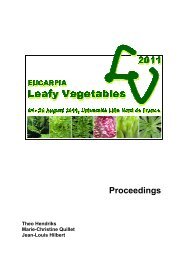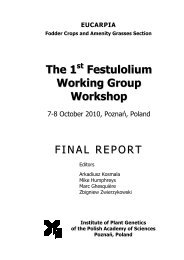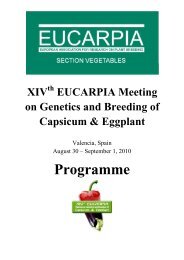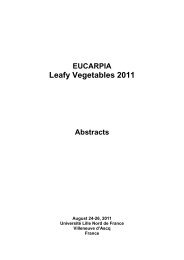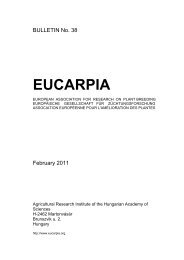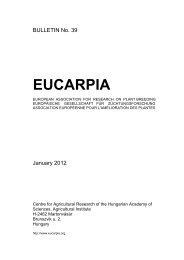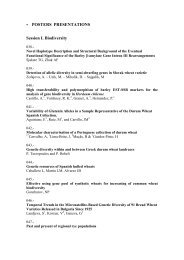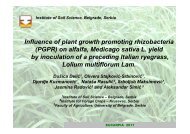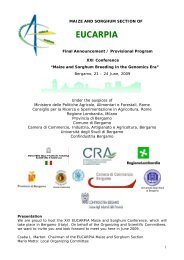Plant breeding for organic and sustainable, low-input agriculture
Plant breeding for organic and sustainable, low-input agriculture
Plant breeding for organic and sustainable, low-input agriculture
Create successful ePaper yourself
Turn your PDF publications into a flip-book with our unique Google optimized e-Paper software.
Selection <strong>for</strong> weed tolerance in soybean<br />
Johann Vollmann <strong>and</strong> Helmut Wagentrist<br />
Department of Applied <strong>Plant</strong> Sciences <strong>and</strong> <strong>Plant</strong> Biotechnology, BOKU - University of Natural<br />
Resources <strong>and</strong> Applied Life Sciences, Vienna, Austria<br />
Soybean (Glycine max [L.] Merr.) has recently proved to be an interesting grain legume crop <strong>for</strong><br />
<strong>organic</strong> farming in Central European countries (Bavec & Bavec, 2006). As a consequence, early<br />
maturity, acceptable agronomic per<strong>for</strong>mance <strong>and</strong> quality features such as high seed protein<br />
content, large seed weight or yel<strong>low</strong> hilum are important features <strong>for</strong> food grade soybeans. As<br />
soybean is s<strong>low</strong>ly developing during early stages of crop establishment, competition of the<br />
soybean crop with seed-propagated weeds is important, <strong>and</strong> weed control is a major challenge<br />
<strong>for</strong> farmers. Genetic variation in weed suppression or weed tolerance of soybean is largely<br />
unknown. As soybean does not show significant allelopathic effects in general, genetic<br />
differences in competitiveness against weeds might be due to mechanisms such as rapid<br />
development during juvenile stages (Jannink et al., 2000), branching habit or weed shading<br />
through increased leaf area or leaflet shape. There<strong>for</strong>e, an experiment was initiated in order to<br />
identify differences in competitiveness of soybean cultivars against weeds, by which selection<br />
criteria <strong>for</strong> weed tolerance might subsequently be established.<br />
During the 2005 <strong>and</strong> 2006 growing seasons, twelve soybean genotypes were either grown in<br />
weed-free plots or in plots with heavy weed infestation in a split-plot experimental design at a<br />
location near Vienna/Austria. Weed infestation was simulated by broad-sowing of winter oilseed<br />
rape seeds after the emergence of soybean. Grain yield as well as other agronomic <strong>and</strong> seed<br />
quality characters were recorded <strong>for</strong> pure st<strong>and</strong>s <strong>and</strong> simulated weed st<strong>and</strong>s, <strong>and</strong> grain yield<br />
reduction by weed infestation was determined <strong>for</strong> individual genotypes.<br />
Weed infestation had statistically significant effects on various characters of soybean. Across all<br />
genotypes, weed infestation caused a delay in time to maturity by about 2 days, a reduction in<br />
plant height by 12 cm <strong>and</strong> a decrease in grain yield by 450 kg/ha (i.e. 20 % in average).<br />
Thous<strong>and</strong>-seed weight was increased from 157 to 165 g, <strong>and</strong> seed protein content was also<br />
significantly increased from 342 to 350 g/kg by weed infestation. Yield reduction of individual<br />
cultivars was between 0 <strong>and</strong> 48 % <strong>and</strong> between 0 <strong>and</strong> 20 % <strong>for</strong> the 2005 <strong>and</strong> 2006 growing<br />
seasons, respectively. Moreover, yield reduction of individual genotypes was clearly<br />
reproducible over the two years indicating a genetic difference in this character. The degree of<br />
yield reduction by weed infestation <strong>for</strong> individual cultivars was not related with leaf area, but<br />
significantly correlated with time to maturity. There<strong>for</strong>e, the lesser yield reduction in early<br />
maturing cultivars as compared to late cultivars should be considered as weed tolerance rather<br />
than weed suppression under the experimental conditions applied.<br />
44




